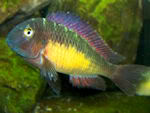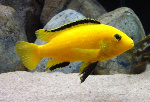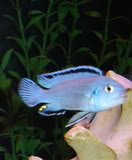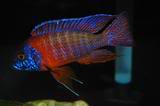Introduction to Cynotilapia
+5
Aura
Micheal
Rift_Lakes_Rule
buntbarsch
why_spyder
9 posters
Page 1 of 1
 Introduction to Cynotilapia
Introduction to Cynotilapia
What are Cynotilapia?
Cynotilapia (pronounced SIGH-no-TILAPIA) is a genus of mbuna in Lake Malawi that are known for their unique, unicuspid teeth. The latin name Cynotilapia literally breaks down to "dog-tilapia" in reference to their teeth. Despite the aggressive look of these mbuna, they are predominantly plankton feeders - harvesting zoo- and phytoplankton from the open water. However, it is thought the the shape of teeth may infact be designed for defense, rather than feeding technique.
In the wild, Cynotilapia are found in the deep rocky, intermediate, and even the sediment-rich habitats - where the rocky shoreline meets the open sands of the lake. Females and subdominant males form large schools and spend a lot their time foraging in the open water. Dominant males will hold up in or around large dark caves, boulders, and in some cases, around small clusters of rocks amongst the sand.
Cynotilapia show a high degree of variation amongst many species - the C. sp. lion and C. sp. mbamba groups are good examples. At Lion's Cove, male C. sp. lion range from a golden yellow (with little purple) to almost all purple (with little golden yellow) - with intermediate consitancies appearing as well. In some populations of C. sp. mbamba there is polychromatism (variance in coloration) in the dorsal fins - displaying a range of coloration between yellow and white.
At many locations, there is more than one species of Cynotilapia to be found. For example, at Nkhata Bay there is three species found there: C. sp. mbamba, C. afra, and C. axelrodi. All can be found there, but they all inhabit different niches in the biotope.
There are two described and several undescribed species of Cynotilapia. Cynotilapia afra is the first described species (C. axelrodi being the other), and is by far the largest group of this genus. This species has a widespread distribution covering much of the lake - C. afra comes in a wide variety of color combinations which makes them so appealing. Cynotilapia afra are mostly black-barred on a blue-body with slight coloration differences between locations. At Cobwe, Mozambique - a very popular species of C. afra is found that goes by the tradename "Orangeback Cobue" or simply "Afra Cobue". This species is well known for the brilliant yellow/orange-coloration that runs from head to tail along the upper half of the body.
A second major group is C. sp. "Lion". This group differs from C. afra in two ways. The first noticeable difference is the body shape - C. sp. "Lion"'s are more elongate then most of the C. afra species. Secondly, C. sp. "Lion" are characterized by the male behavior. Males will form a territory around a singular rock or small group of rocks and actually hover above their domain approximately 4"-6". Cynotilapia sp. "Lion" are only found in the northern half of Lake Malawi.
Cynotilapia sp. "Mbamba" is the third major group found in Lake Malawi. Like the previous group, C. sp. "Mbamba" has a couple unique features that set them apart from the others. The bodies of this group are more laterally compressed, and the overall coloration of the bodies are dark. Males prefer the dark regions of the biotope - usually found in the entrance of large, dark caves. At a couple of the geographical locations, males exhibit a streak of color on their forehead that runs up into the dorsal fin. C. sp. "Mbamba" are found predominately in the northern half of the lake.
Both the C. sp. lion and C. sp. mbamba groups are undescribed officially, so members of each group (and the C. afra group for that matter) may be moved around in the future as further inspection occurs. An addition, the whole lake has not been fully explored - the southeastern part of the lake has rougher, less clear water that makes exploring difficult (Larry Johnson, pers. comm.). A few other species that still need to be described are C. sp hara, C. sp. maleri, C. sp. ndumbi, C. sp. black dorsal, and C. sp. black eastern.
How big do these get?
Most of the Cynotilapia species only grow to about 4" at full maturity. Cynotilapia sp. "Hara" and C. sp. "Chinyankwazi" are two species that have been known to grow larger than 4" - reaching 5". This smaller size allows for a slightly smaller tank size to be used if necessary - even though bigger tanks still work better.
What is their temperament?
From my experience, Cynotilapia run middle of the road as far as aggression - both within their species and towards other species. As with every genus, there are a few species that are known for being more or less aggressive. Cynotilapia sp. "Hara" is a bit more aggressive, as well as C. sp. "Lion" Mara Rocks (so I've heard). On the other end of the aggression scale, C. afra Cobwe is more docile and can be more easily intimidated by robust species of cichlid. Species like C. sp. "Mbamba" aren't pushovers but can be quite shy until they find a niche within a community.
What kind of tank inhabitants will work with Cynotilapia?
Tankmates will depend on many factors: the temperament of the Cynotilapia involved, tank size, and number of fish to be housed to name a few. Generally speaking, Cynotilapia will work well with most mbuna - provided they aren't of similar color pattern. It is always recommended that you consult others before mixing species if you don't want to risk the loss of fish. On a personal note, I have had very good results so far with mixing Cynotilapia species with all kinds of mbuna - and even with some Aulonocara and Copadichromis species.
Is there a minimum tank size?
Assuming you are doing a species-only tank, I recommend at least a 3' tank. Even though they don't grow as large as many other mbuna - males still establish territories like their bigger counterparts. Male Cynotilapia can be quite boisterous around spawning time and can harass females/subdominant males - and these "victims" will need room to escape.
How hard are Cynotilapia to come by?
Nowadays, finding Cynotilapia is much easier with the internet as a shopping tool - people are no longer stuck with what they can find at their local fish stores. There are several online stores, online auction sites, and the "For Sale" areas of forums to browse through for species. Species like C. afra Cobwe are quite common and can be found fairly easily (even at many fish stores). Cynotilapia sp. "Hara" is really growing in popularity and is getting easier to find. If the rare and unusual is more your style, there will be more searching involved - which may only leave the option of contacting importers.
Where can more information be found about these?
A lot of information can be found in and around the many cichlid forums out there online. There are definitely some experienced Cynotilapia keepers out there (more experienced than I) - and they are filled with tips, tricks, and compatability-related information. Also, I highly recommend picking up a copy of Ad Koning's Malaŵi Cichlids in their natural habitat (either 3rd or 4th Edition) for great background information. The books have a lot of photos and really explain how these fish live in the wild. If the books don't have enough photos for you, Ad has a CD of photos available on his site (http://www.cichlidpress.com) that has over 5,000(!) species images.
I would like to personally thank Larry Johnson and Nick Andreola for their input into this article, and I'd like thank everyone that has helped me with my Cynotilapia obsession over the past couple years.
Cynotilapia (pronounced SIGH-no-TILAPIA) is a genus of mbuna in Lake Malawi that are known for their unique, unicuspid teeth. The latin name Cynotilapia literally breaks down to "dog-tilapia" in reference to their teeth. Despite the aggressive look of these mbuna, they are predominantly plankton feeders - harvesting zoo- and phytoplankton from the open water. However, it is thought the the shape of teeth may infact be designed for defense, rather than feeding technique.
In the wild, Cynotilapia are found in the deep rocky, intermediate, and even the sediment-rich habitats - where the rocky shoreline meets the open sands of the lake. Females and subdominant males form large schools and spend a lot their time foraging in the open water. Dominant males will hold up in or around large dark caves, boulders, and in some cases, around small clusters of rocks amongst the sand.
Cynotilapia show a high degree of variation amongst many species - the C. sp. lion and C. sp. mbamba groups are good examples. At Lion's Cove, male C. sp. lion range from a golden yellow (with little purple) to almost all purple (with little golden yellow) - with intermediate consitancies appearing as well. In some populations of C. sp. mbamba there is polychromatism (variance in coloration) in the dorsal fins - displaying a range of coloration between yellow and white.
At many locations, there is more than one species of Cynotilapia to be found. For example, at Nkhata Bay there is three species found there: C. sp. mbamba, C. afra, and C. axelrodi. All can be found there, but they all inhabit different niches in the biotope.
There are two described and several undescribed species of Cynotilapia. Cynotilapia afra is the first described species (C. axelrodi being the other), and is by far the largest group of this genus. This species has a widespread distribution covering much of the lake - C. afra comes in a wide variety of color combinations which makes them so appealing. Cynotilapia afra are mostly black-barred on a blue-body with slight coloration differences between locations. At Cobwe, Mozambique - a very popular species of C. afra is found that goes by the tradename "Orangeback Cobue" or simply "Afra Cobue". This species is well known for the brilliant yellow/orange-coloration that runs from head to tail along the upper half of the body.
Cynotilapia afra Lupingu, male


A second major group is C. sp. "Lion". This group differs from C. afra in two ways. The first noticeable difference is the body shape - C. sp. "Lion"'s are more elongate then most of the C. afra species. Secondly, C. sp. "Lion" are characterized by the male behavior. Males will form a territory around a singular rock or small group of rocks and actually hover above their domain approximately 4"-6". Cynotilapia sp. "Lion" are only found in the northern half of Lake Malawi.
Cynotilapia sp. "Lion" Lion's Cove, male


Cynotilapia sp. "Mbamba" is the third major group found in Lake Malawi. Like the previous group, C. sp. "Mbamba" has a couple unique features that set them apart from the others. The bodies of this group are more laterally compressed, and the overall coloration of the bodies are dark. Males prefer the dark regions of the biotope - usually found in the entrance of large, dark caves. At a couple of the geographical locations, males exhibit a streak of color on their forehead that runs up into the dorsal fin. C. sp. "Mbamba" are found predominately in the northern half of the lake.
Cynotilapia sp. "Mbamba" Mphanga Rocks, male and female (courtesy of Steve Suchon)


Both the C. sp. lion and C. sp. mbamba groups are undescribed officially, so members of each group (and the C. afra group for that matter) may be moved around in the future as further inspection occurs. An addition, the whole lake has not been fully explored - the southeastern part of the lake has rougher, less clear water that makes exploring difficult (Larry Johnson, pers. comm.). A few other species that still need to be described are C. sp hara, C. sp. maleri, C. sp. ndumbi, C. sp. black dorsal, and C. sp. black eastern.
How big do these get?
Most of the Cynotilapia species only grow to about 4" at full maturity. Cynotilapia sp. "Hara" and C. sp. "Chinyankwazi" are two species that have been known to grow larger than 4" - reaching 5". This smaller size allows for a slightly smaller tank size to be used if necessary - even though bigger tanks still work better.
What is their temperament?
From my experience, Cynotilapia run middle of the road as far as aggression - both within their species and towards other species. As with every genus, there are a few species that are known for being more or less aggressive. Cynotilapia sp. "Hara" is a bit more aggressive, as well as C. sp. "Lion" Mara Rocks (so I've heard). On the other end of the aggression scale, C. afra Cobwe is more docile and can be more easily intimidated by robust species of cichlid. Species like C. sp. "Mbamba" aren't pushovers but can be quite shy until they find a niche within a community.
What kind of tank inhabitants will work with Cynotilapia?
Tankmates will depend on many factors: the temperament of the Cynotilapia involved, tank size, and number of fish to be housed to name a few. Generally speaking, Cynotilapia will work well with most mbuna - provided they aren't of similar color pattern. It is always recommended that you consult others before mixing species if you don't want to risk the loss of fish. On a personal note, I have had very good results so far with mixing Cynotilapia species with all kinds of mbuna - and even with some Aulonocara and Copadichromis species.
Is there a minimum tank size?
Assuming you are doing a species-only tank, I recommend at least a 3' tank. Even though they don't grow as large as many other mbuna - males still establish territories like their bigger counterparts. Male Cynotilapia can be quite boisterous around spawning time and can harass females/subdominant males - and these "victims" will need room to escape.
How hard are Cynotilapia to come by?
Nowadays, finding Cynotilapia is much easier with the internet as a shopping tool - people are no longer stuck with what they can find at their local fish stores. There are several online stores, online auction sites, and the "For Sale" areas of forums to browse through for species. Species like C. afra Cobwe are quite common and can be found fairly easily (even at many fish stores). Cynotilapia sp. "Hara" is really growing in popularity and is getting easier to find. If the rare and unusual is more your style, there will be more searching involved - which may only leave the option of contacting importers.
Where can more information be found about these?
A lot of information can be found in and around the many cichlid forums out there online. There are definitely some experienced Cynotilapia keepers out there (more experienced than I) - and they are filled with tips, tricks, and compatability-related information. Also, I highly recommend picking up a copy of Ad Koning's Malaŵi Cichlids in their natural habitat (either 3rd or 4th Edition) for great background information. The books have a lot of photos and really explain how these fish live in the wild. If the books don't have enough photos for you, Ad has a CD of photos available on his site (http://www.cichlidpress.com) that has over 5,000(!) species images.
I would like to personally thank Larry Johnson and Nick Andreola for their input into this article, and I'd like thank everyone that has helped me with my Cynotilapia obsession over the past couple years.
 Re: Introduction to Cynotilapia
Re: Introduction to Cynotilapia
Great Article Brian!!! Thanks for sharing it with us 

Rift_Lakes_Rule- Admin
- Posts : 1752
Join date : 2009-06-27
Age : 51
Location : West Virginia 25427
 Re: Introduction to Cynotilapia
Re: Introduction to Cynotilapia
Very informative article Brian great job.

Micheal- Admin
- Posts : 587
Join date : 2009-06-27
Age : 47
Location : Picayune, MS
 Re: Introduction to Cynotilapia
Re: Introduction to Cynotilapia
Excellent article.

Aura- Admin
- Posts : 2580
Join date : 2009-08-14
Location : WA
 Re: Introduction to Cynotilapia
Re: Introduction to Cynotilapia
Good presetation on Cynotilapia  .
.

theswede- Posts : 2120
Join date : 2009-11-18
Age : 56
Location : Timrå, Sweden
 Re: Introduction to Cynotilapia
Re: Introduction to Cynotilapia
Great informative article, Brian!
I haven't kept any cyno's yet, but this gets me thinking about it!
I haven't kept any cyno's yet, but this gets me thinking about it!

preacherboy- Competition Committee
- Posts : 344
Join date : 2009-11-26
Age : 63
Location : Kentucky
 Re: Introduction to Cynotilapia
Re: Introduction to Cynotilapia
Good info..

cichlidman- Competition Committee
- Posts : 968
Join date : 2009-11-26
Age : 74
Location : Winchester Tn.
Page 1 of 1
Permissions in this forum:
You cannot reply to topics in this forum


